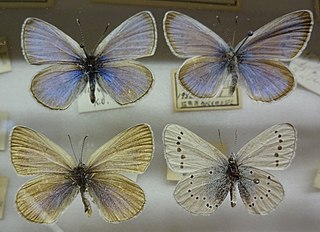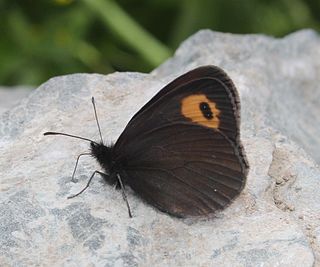
The silver-washed fritillary is a common and variable butterfly found over much of the Palearctic realm – Algeria, Europe and across the Palearctic to Japan.

Lycaena phlaeas, the small copper, American copper, or common copper, is a butterfly of the Lycaenids or gossamer-winged butterfly family. According to Guppy and Shepard (2001), its specific name phlaeas is said to be derived either from the Greek φλέγω (phlégo), "to burn up", or from the Latin floreo, "to flourish".

The dark green fritillary is a species of butterfly in the family Nymphalidae. The insect has a wide range in the Palearctic realm - Europe, Morocco, Iran, Siberia, Central Asia, China, Korea, and Japan.

Aporia crataegi, the black-veined white, is a large butterfly of the family Pieridae. A. crataegi is widespread and common. Its range extends from northwest Africa in the west to Transcaucasia and across the Palearctic to Siberia and Japan in the east. In the south, it is found in Turkey, Cyprus, Israel, Lebanon and Syria. It is not usually present in the British Isles or northern Scandinavia.

The Satyrini is one of the tribes of the subfamily Satyrinae. It includes about 2200 species and is therefore the largest tribe in the subfamily which comprises 2500 species.

Scolitantides orion, the chequered blue, is a species of butterfly in the family Lycaenidae. It is found in Europe, Russia and east across the Palearctic to Japan.

Favonius is a Palearctic genus of butterflies in the family Lycaenidae.

Colias palaeno, known by the common names moorland clouded yellow, palaeno sulphur, and pale Arctic clouded yellow, is a butterfly in the family Pieridae.

Abraxas grossulariata is a moth of the family Geometridae, native to the Palearctic realm and North America. Its distinctive speckled coloration has given it a common name of magpie moth. The caterpillar is similarly coloured to the adult, and may be found feeding on the leaves of shrubs such as gooseberry and blackcurrant. The species was first described by Carl Linnaeus in his 1758 10th edition of Systema Naturae.

Coenonympha hero, the scarce heath, is a butterfly species belonging to the family Nymphalidae.

Lethe diana, the Diana treebrown, is a brush-footed butterfly in the family Nymphalidae. Its wings are a dark shade of brown, with an eyespot pattern, and a wingspan of about 45–55 mm. It resembles Lethe confusa; however, the Lethe confusa bears a white band on its wings, setting them apart.
Nemophora karafutonis is a moth of the family Adelidae or fairy longhorn moths. It was described by Shōnen Matsumura in 1932. It is found in the Russian Far East and Japan.
Asthena sachalinensis is a moth in the family Geometridae. It is found on Sakhalin, the Kuriles and in Japan.

Glaucopsyche lycormas is a butterfly of the family Lycaenidae. It is found in the East Palearctic in Siberia, Mongolia, China, Korea and Japan.

Aeromachus inachus is a butterfly in the family Hesperiidae (Hesperiinae). It is found in the East Palearctic in Ussuri, Amur, Taiwan, Japan. The larva on feeds on Spodiopogon sibiricus and other Gramineae. There are two or more broods. The larva of this species hibernates.

Erebia niphonica is an East Palearctic species of satyrine butterfly endemic to Japan, Sakhalin and the Kuril Islands.

The South Sakhalin-Kurile mixed forests ecoregion is split between the southwest region of Sakhalin Island, and the southern three islands of the Kurile Islands chain in the Russian Far East. The ecoregion is in the Palearctic realm, with a Humid Continental climate. It covers 12,432 km2 (4,800 sq mi).
















